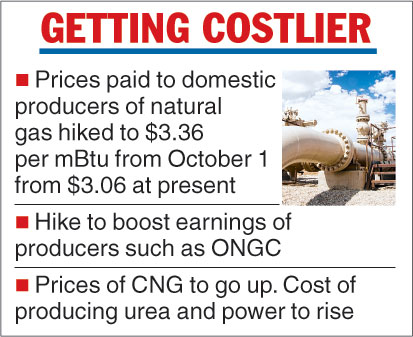Natural gas consumers in the country will have to pay more as the government on Friday hiked prices by 10 per cent to a three-year high of $3.36 per million British thermal unit (mBtu) for the next six months beginning October from $3.06 per mBtu.
At the same time, the Petroleum and Natural Gas Regulatory Board (PNGRB) has hiked the pipeline tariff in the range of 27 per cent to 691 per cent for seven pipelines belonging to GAIL India, IOC and Gujarat State Petronet Corporation (GSPC). The PNGRB said the new prices will be applicable from April 1, 2018.
The tariffs for GAIL’s Agartala Regional Natural Gas Pipeline has been increased to Rs 45.89 per mBtu from Rs 5.80 per mBtu and for the Dukli Maharajganj Natural Gas Pipeline to Rs 46.37 per mBtu from Rs 6.13 per mBtu.
While the increase in gas prices will boost the revenues of exploration firms such as ONGC and Oil India, the hike in the pipeline tariff will benefit transportation firms. Shares of GSPC rose 4.05 per cent on the BSE, while the GAIL (India) stock jumped 6.35 per cent.

Telegraph infographic
The government has also set a ceiling price for gas to be produced from difficult fields at $7.67 per mBtu for October-March compared with $6.78 per mBtu in the previous six months, a notification issued by the oil ministry showed. The prices will be applicable on a gross heat value basis.
Natural gas prices are set every six months based on average rates in gas-surplus nations such as the US, Russia and Canada.
While the increase in the gas price will provide some relief to the domestic producers who have been selling it at below cost, it will put pressure the margins of the retail fuel distributors and fertiliser and power producers that use gas as feedstock.
According to estimates, every dollar increase in gas prices boosts the annual revenue of ONGC by about Rs 4,100 crore.
Fertiliser and power companies also import LNG and pool the prices to calculate their overall costs. The hike may provide some cushion to their margins as they would look to increase the mix of imported LNG, depending on its prices in the international open markets.











